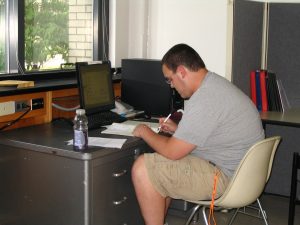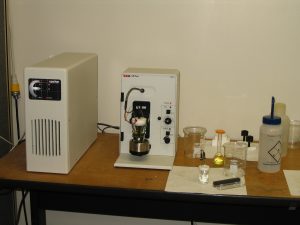The experiment on 21C is currently in unscheduled off as some repairs are made to the cyclotron here at the National Superconducting Cyclotron Lab. In one picture we see Eric working on some data analysis while waiting for the beam. The other picture shows that he is actually the experimenter-in-charge for the experiment (upper right corner, click on the image).
Surface Lab
 Research in Jenny Hampton’s Group (the Surface Lab) started this week. Here is Nick Wozniak working on some analysis that was left over from his work during the spring semester. He is characterizing the Teflon electrochemical cell that was designed last summer for doing electrochemistry on wafer samples.
Research in Jenny Hampton’s Group (the Surface Lab) started this week. Here is Nick Wozniak working on some analysis that was left over from his work during the spring semester. He is characterizing the Teflon electrochemical cell that was designed last summer for doing electrochemistry on wafer samples.
 Alyssa Frey, a student from UW-Eau Claire, is new to the Surface Lab. Here she is looking at some of her first electrochemical data, the cyclic voltammetry of K3Fe(CN)6, a test molecule. She used the standard electrochemical cell (below) and a Pt disk electrode.
Alyssa Frey, a student from UW-Eau Claire, is new to the Surface Lab. Here she is looking at some of her first electrochemical data, the cyclic voltammetry of K3Fe(CN)6, a test molecule. She used the standard electrochemical cell (below) and a Pt disk electrode.
Friday Afternoon Progress in the Nuclear Group
Here is Matt after a good day of IBIL and PIXE on various mineral grains (zircons, etc.) The ion source is cooling and he is cleaning his sample holders.
Eric made this great plot to help us understand the properties of the fragments from the decay of 13Li, 12Li, and 9He. Each of these unstable nuclei emit neutrons when they break up after surviving about 10-20 seconds
Tim’s week ended with manual labor after the low background counting station was found to be grossly contaminated. Here he is washing one of the lead shielding blocks.
Night Sky
Nuclear group at MoNA collaboration meeting
These are the MoNA collaborators at Westmont College. This morning Eric Lunderberg and Paul DeYoung, showed them how to sort our 13Li->11Li+2n data files so they can develop algorithms for finding events containing exactly two neutrons. This was done via videoconferencing and desktop sharing since they are located in California.




